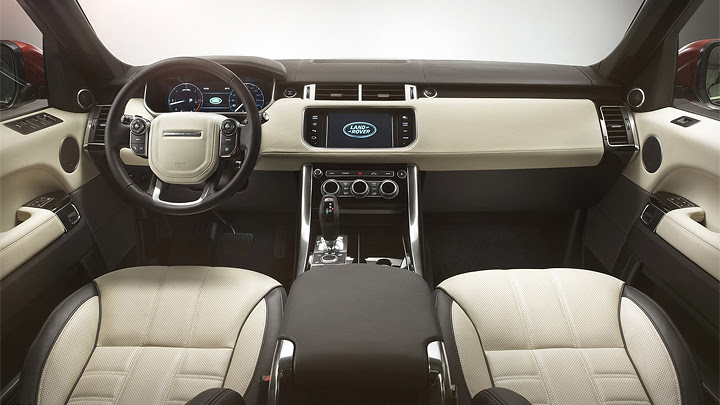
Even though the first Sport looked very much like the contemporary Range Rover, it actually shared construction and platform with Discovery, Land Rover’s mid-size SUV. The intention was to extend the flagship car’s great reputation to a less-formal interpretation, delivering a similar amount of luxury and sophistication focused on sporty driving rather than following those traditions once again. Sport’s initial phase could be labeled as this automaker’s very first attempt to subvert its own past, because Freelander’s smooth volumes and round shapes were nothing but a late-1990s styling applied to a smaller-scale Discovery.
The surprise came when the company decided they could dig a little deeper and extend the Range Rover badge to a car which could’ve never been expected from Land Rover. This article stated it was easy to think Evoque would replace Sport because it could be considered as an evolution of that subversive attitude – while the older only abandoned the original platform, Evoque restricted the style similarities literally to the famous hood logotype. The great news, however, was that Land Rover’s true decision turned to be offering both traditional vehicles not only side-by-side but also with extensive technology sharing.








In other words, with the exception of Defender they all share an excellent overall quality, letting each customer choose its future car based only on each one’s proposal. Freelander, for instance, replaced its V6 engine with Evoque’s turbo 2.0L to become more efficient. Sport’s latest way of keeping the excellent sales without competing with any sibling is to place itself at the exact halfway between Evoque and the original Range Rover. The exterior design is the best way of proving that, actually: having the older’s overall shapes tuned with the younger’s more casual details is like the new Sport became a “biological son” of those. However, this time it was used the bigger brother’s platform, which brought a lot of benefits to the new Sport: the 7-inch increased wheelbase enabled to complete seven seats, while there’s much more technology and an 800-pounds lighter weight.
The second generation of Terrain Response 2 now decides which settings to use by analyzing the ground, the air suspension features four ride heights and the safety is bigger than ever, which lots of electronic programs to enhance the driving, prevent accidents or protect the occupants when they can’t be avoided. The cabin was improved in comfort and technology, with an available 12,3” touchscreen as dashboard. And when it comes to the powertrain, there are electric steering, start/stop and eight-speed gearbox to make the best of the new 340-hp V6 3.0L, which can be changed for an also supercharged 510-hp V8 5.0L, this one shared with Range Rover.
Lançamento no Brasil (28/10/2013)
Pouco depois do seu irmão “clássico”, agora é a nossa vez de receber a variação informal, curiosamente apenas alguns dias mais tarde que um dos seus principais rivais, o BMW X5. As evoluções citadas acima lhe trouxeram tantas melhorias que ele teria tudo para disputar vendas com o irmão mais velho, se a diferença de intenções que mantêm não fosse tão clara. O Sport honra o papel de seduzir os gostos mais casuais sem deixar de surpreender: sua luxuosa cabine inclui a tela tátil de 8” com dupla visão, que mostra em simultâneo uma imagem quando vista do ângulo do assento do motorista e outra para o ângulo do passageiro da frente.
Outros destaques são sistema de áudio Meridian em três níveis, revestimento em couro com até três tons, suspensão ativa, teto solar elétrico e o Terrain Response em duas opções, entre vários outros. Essa lista se distribui entre a ampla lista de versões na qual este carro chega ao Brasil. Sempre com câmbio automático de oito marchas, o 3.0 V6 a gasolina gera 340 cv e 45,9 e vem na versão HSE por R$ 393.500. Já o 3.0 V6 turbodiesel passa a 292 cv e 61,2 kgfm e equipa as SE (R$ 377.500) e HSE (R$ 405.500). Por fim, os 510 cv e 63,7 kgfm do 5.0 V8 aparecem em HSE Dynamic (R$ 496.500), HSE Autobiography (R$ 530.900) e Autobiography Dynamic (R$ 539.900).
Land Rover Range Rover Sport SVR (27/05/2015)
Foram iniciadas as vendas brasileiras de um dos utilitários esportivos mais rápidos do mundo. A nova variação do Range Rover Sport foi preparada pela nova divisão esportiva do grupo Jaguar Land Rover, e começa a seduzir por fora: entradas de ar maiores, defletores por toda a parte inferior, parachoques mais agressivos, rodas exclusivas de 21”, e escapamento com quatro saídas. Por dentro, acabamento em alumínio, bancos esportivos, e mais detalhes de estilo exclusivos. Também vieram várias melhorias técnicas, incluindo freios Brembo, mas o destaque é o motor 5.0 V8, que oferece 550 cv e 69,3 kgfm. Usando câmbio automático de oito marchas e tração integral, ele o leva de 0 a 100 km/h em 4,5 segundos e depois ao limite de 260 km/h. Este modelo custa R$ 595 mil.